warriorpublications.wordpress.com
The World Cup started today, and with it the culmination of a much longer power battle between Brazilians who vehemently detest the World Cup and the authorities who defend it.
Hours before the opening game of the World Cup, Brazilians took to the streets once again to protest and disrupt the games — the most expensive World Cup in history, which cost Brazil over $11 billion. In São Paulo, Rio de Janeiro, and Belo Horizonte, protesters clashed with police while blocking a highway, trying to enter a stadium, protesting public spending, and rioting.
These are bizarre days in Brazil. The country has been on fire for a year, protesting not only the World Cup but public spending, the government, repression, corruption, and inequality as well. The World Cup may continue uninterrupted, but the soccer-loving population of Brazil have good reason to object. Like my friend Nico said the other day, “Brazilians have soccer in their blood. When they’re protesting the World Cup, you know things are really bad.”
This year of revolt started last summer, on June 6 in São Paulo, after the announcement of yet another increase in the transit fare. First, thousands of people showed up to the protest, then tens of thousands, eventually drawing 100,000 protesters in Rio de Janeiro, making it the largest street demonstration in Brazil in 20 years. The demonstrations spread to other parts of the country, and at the end of June there were days with protests in over 100 cities simultaneously, some of the larger cities witnessing protests every day of the week. The biggest protest in Brazil’s history occurred in Rio de Janeiro, with 3 million people in the streets at the end of the Confederations Cup.
While the protests started out as a reaction against the transit fare increases, they evolved into a much wider rejection of the government, public spending, and the military police in general. As it became evident that the majority stood on the side of the protesters (rather than the police) the media flipped from critiquing the riots to trying to understand them. For example, watch this video of a TV pollster being shocked by the vast public support of the riots, specifically vandalism.
Although this year of protests has been formulated as a rejection of the World Cup, the cup should be seen as the droplet that caused the beaker of flagrant inequality between rich and poor to overflow. A common thread in all the protests was the outrage at the misuse of public funds. Altogether, Brazil will spend around 30 billion dollars on the 2014 World Cup and the 2016 Summer Olympics, making the upcoming World Cup the most expensive in history. Meanwhile, FIFA will be 4 billion dollars richer by the end of the summer.
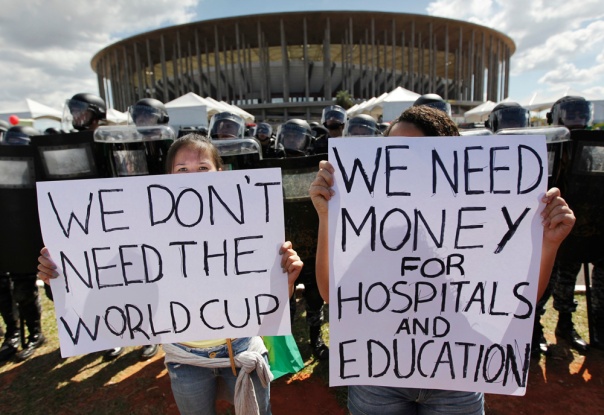 The effects of the World Cup started becoming evident years ago: evictions and home demolitions, the “pacification” of favelas, the construction of highways, stadiums, and luxury hotels. The city centers have witnessed an ethnic and social cleansing, with investors buying whole city blocks, tearing down historically protected buildings and building luxury hotels. Real estate prices have skyrocket and poor residents have been displaced from the city center. While president Dilma Rousseff’s government defends these investments, saying that they ‘put Brazil on the map’ and ‘serve and incentivize future growth,’ most people see this as a big waste of money and as further evidence of the corruption of a government whose interests concern the wealthy and international actors at the expense of everyone else.
The effects of the World Cup started becoming evident years ago: evictions and home demolitions, the “pacification” of favelas, the construction of highways, stadiums, and luxury hotels. The city centers have witnessed an ethnic and social cleansing, with investors buying whole city blocks, tearing down historically protected buildings and building luxury hotels. Real estate prices have skyrocket and poor residents have been displaced from the city center. While president Dilma Rousseff’s government defends these investments, saying that they ‘put Brazil on the map’ and ‘serve and incentivize future growth,’ most people see this as a big waste of money and as further evidence of the corruption of a government whose interests concern the wealthy and international actors at the expense of everyone else.
Between 170 and 250 thousand people have been displaced from their homes without any right to compensation, in addition to the many thousands who have been displaced due to real estate price hikes. Ten people died during the construction of stadiums. While investments in public transportation were canceled, two billion dollars were allocated to the state police for World Cup-related policing efforts. It’s no surprise Brazilians are asking: “Copa pra Quem?” — “Whose Cup?”
Diego: The last year has been very unusual. Things are constantly changing. Social movements have really taken hold and more people than ever are questioning what is going on, and understanding what a big problem the World Cup is to this country.
Throughout the year, the police have been experimenting with new tactics for the kettling and control of mass mobilizations — sound cannons, water cannons, chemical agents, tasers, and rubber bullets. In Belo Horizonte, people fought pending legislation which involved sentences of up to 30 years for participating in illegal protests. Other proposed legislation would place illegal protests in the realm of “terrorism,” and enable the State to declare a “state of exception” during protests.
Normally, this kind of repression is confined to the favelas, away from the gaze of international media. It is easier for the State to justify excessive violence and war against a portion of the population when that population is already marginalized and fairly small. But when the dissenting minority becomes a majority, that justification no longer holds; instead, it becomes apparent that the forces of authority are protecting the powerful elite. The ones paying the price for this extravaganza don’t want it, but between them and the World Cup stand hundreds of thousands of soldiers, police, and robo-cops trained to kill. This is the Hunger Games IRL.
 Ultimately, this is the hyper-violent push of a country into advanced capitalism. Displacement, dispossession, gentrification, murder, exploitation, and revolt are aspects of every country’s transmogrification into advanced capitalism; in some places around the world that development occurs slower, which makes if possible to conceal systemic violence under the guise of the “rehabilitation of individuals” (imprisonment, social benefits, legal processes, and so on). But in the end, the result is the same: obey or pay the price. But,
Ultimately, this is the hyper-violent push of a country into advanced capitalism. Displacement, dispossession, gentrification, murder, exploitation, and revolt are aspects of every country’s transmogrification into advanced capitalism; in some places around the world that development occurs slower, which makes if possible to conceal systemic violence under the guise of the “rehabilitation of individuals” (imprisonment, social benefits, legal processes, and so on). But in the end, the result is the same: obey or pay the price. But,Diego: Nobody expected this to happen, and nobody knows what will happen next. Both the government and the population have been very fickle — things shift very quickly.Even if the protests are being criminalized, this will not stop people from protesting. There isn’t a single group who is organizing, there are many different movements and it’s impossible to stop all of them. Nobody knows what will happen during the World Cup. We are all exited.
The World Cup Exposes Brazil’s Injustices
On June 12th the World Cup kicks off in Brazil; the country has been beset by protest in the run up to the tournament.
Bianca Jagger,Huffington Post, June 4, 2014
Last year up to a million people demonstrated across Brazil: protesting the vast expense of the World Cup, calling for better public services and an end to corruption. On June 3rd, the police were accused of heavy handedness as protestors gathered outside the World Cup Stadium in Goiania, during a friendly football match between Brazil and Panama. The demonstrators condemn the 15 billion dollars spent on the tournament which could have gone towards social services and improving living standards for the poor of Brazil. It’s the latest in a long line of demonstrations.
But now Brazil’s poor favela residents and the indigenous and tribal people have joined forces. On May 28th in Brasilia, 1,500 residents of the favelas, indigenous people, students and many other Brazilians from all walks of life took to the streets, gridlocking them for hours. Some occupied the roof of the Brazilian Congress, including members of the indigenous Guarani tribe who carried banners saying, ‘Guarani resiste, Demarcacao ja!’ ‘The Guarani are resisting. Yes to demarcation!’
Police fired tear gas and stun grenades into the crowd. One policeman was reportedly shot in the leg with an arrow.
At first glance the inhabitants of Brazil’s urban slums, the favelas, and the indigenous people of the Brazilian Amazon may not seem to have a common cause. But both groups face violence with impunity from police and the military, poverty, land insecurity, neglect by the authorities. The Brazilian government is brushing them under the carpet.
On June 9th the legendary Chief Raoni Metuktire and his nephew Chief Megaron Txucarramãe, members of the Mebengôkre Kayapó tribe in the Brazilian Amazon, will arrive in London to gather support for the Kayapó and for all the tribes across Brazil in their struggle to protect their ancestral lands and way of life. They are urging the Brazilian government to demarcate the region known as Kapôt-Nhinore, which is sacred to the Kayapó. They will be holding a press conference on June 9th – I will be there to speak in their support, as Founder and Chair of the Bianca Jagger Human Rights Foundation (BJHRF).
It is a critical time for indigenous rights in Brazil. The Kayapó, and all the indigenous peoples of the Amazon are threatened; by mega-dams, illegal mining, logging, occupation by settlers and ranchers, and by companies and large corporations, by proposed legal reform and constitutional amendments which if allowed to go ahead will strip the tribes of their territorial rights, and endanger their livelihoods and cultures.
Throughout my life I have campaigned on behalf of indigenous peoples all over the world: in South America, Asia and Africa. I have witnessed the suffering of many of these ancient tribes, murdered, threatened, abused, forced from their homes and deprived of their way of life. Millions of indigenous people have become refugees in their own land and we don’t know how many thousands have lost their lives.
The values of indigenous people have shaped my relationship to the earth, and our responsibilities towards her. During my thirty years of campaigning for human rights, social justice and environmental protection, I have campaigned on behalf of many indigenous tribes in Latin America: the Miskitos and Mayangna in Nicaragua, the Yanomami, the Guarani, and the Surui Paiter in Brazil, the Cofán, Siona, Secoya, Kichwa, and Huaorani tribes in Ecuador, and the Quechua in Peru. I learned from their wisdom, and also from their courage. Traditional indigenous cultures use natural resources sustainably: forests, grasslands, rivers and wildlife, and preserve biodiversity. Protecting the rights of indigenous peoples is essential to our survival and that of the planet. Over and over again, indigenous peoples have been proven to be the best custodians of biodiversity in their ancestral lands.
Brazil’s 1988 constitution recognises that the Indians have an ‘Original’ and inalienable right to occupy and use their traditional lands. If it can be shown that the tribe historically occupied and used that area of land, it is theirs by right – it should become demarcated land.
Kapôt-Nhinore has already been surveyed by the indigenous agency FUNAI for demarcation, but the process has been stalled by bureaucracy, and is threatened by proposed changes to Brazil’s demarcation laws and constitution.
In the past Brazil had an average of thirteen demarcations per year. Under President Dilma Rousseff this number has sunk to three a year. The demarcation process has been crippled by an unrelenting barrage of legislative proposals from Congressmen representing large agribusiness, mining corporations and the dam industry, designed to wrest the land from the indigenous tribes and open it to development. It is unconscionable. I urge President Rousseff to halt the Proposed Constitutional Amendment (PEC215) which would further delay the process for demarcations and claims: and would result in few, if any further demarcations being approved.
Brent Millikan of International Rivers states, ‘constitutional amendment PEC 215 would transfer authority for demarcation of indigenous lands from the Executive branch to the Congress.’ Demarcation would become a political decision; power of the Executive being transferred to the Legislature, an abuse of the separation of powers, a foundation stone of the Constitution. Since the Congress is today dominated by the Bancada Ruralista – the large landowners’ lobby – it is highly unlikely that any demarcation would be granted. Even if it were, finding time for Congress to debate each demarcation would mean even more delays introduced into the process. Because the change would effectively be retrospective, Congress would also acquire the power to reduce or reverse territories (TI’s) which have already been demarcated.
I urge President Rousseff to halt PEC 215 and the other proposed amendments to the Brazilian Constitution and laws which are eroding the indigenous peoples’ right to their ancestral lands. Some proposals would open up indigenous territories for mineral and oil extraction – mining companies have already begun to lodge claims to the territory. Some would not only permit, but effectively force the indigenous people to allow cattle ranching and agriculture on their land. If allowed to go ahead, these changes could destroy the forest and traditional lives of the Kayapó and many other tribes across Brazil.
I call on the Brazilian government to enforce the Kayapó’s rights to their land, which are enshrined in the 1988 Constitution. I appeal for protection for the hundreds of tribes in the Brazilian Amazon who are continually threatened by landowners, illegal mining, logging, occupation by settlers and ranchers, and by companies and large corporations which continue to trade in produce from illegally farmed crops on indigenous territory, by reckless development projects which threaten their lives and livelihoods. Otherwise indigenous people will continue to be murdered, abused and pushed off their ancestral land.
Among the most monstrous of these projects is the Belo Monte Dam, which is under construction on the Xingu River in the Brazilian state of Pará, in the heart of the Brazilian Amazon. Belo Monte will be more than a dam; it is a megadam, the third largest in the world, which will displace 20,000 people and change the Amazon basin forever. It is a grave human rights.
violation and an environmental crime
I have campaigned against Belo Monte for many years. In March 2012 I went on a fact finding mission to the Xingu. Construction on the dam had then just begun. I travelled down the Xingu River in a small boat. I was accompanied by my courageous friend Antonia Melo, co-ordinator of Xingu Vivo, a collective of local NGOs opposed to Belo Monte, and Ruy Marques Sposati. We saw the great red scarred coffer dams, the beginnings of Belo Monte, rearing out of the river. I met with indigenous leaders, with local communities, NGOs, government officials, extractavists – and the Bishop of the Xingu, Dr Erwin Krautler, whose concern and care for the people affected by Belo Monte was evident. I was distraught by the suffering I witnessed in the area. I published my findings in a report on the Huffington Post: The Belo Monte Dam, an Environmental Crime. I urge you to read it. The people of the Xingu need our support.
And Belo Monte is only part of the plan: on 25 April 2014 it was disclosed in Lima, Peru that 412 dams are planned across the Amazon. 256 of them are in Brazil, 77 in Peru, 55 in Ecuador, 14 in Bolivia, six in Venezuela, two in Guyana, and one each in Colombia, French Guyana and Surinam. Five of the six rivers which run through the world’s largest tropical forest will be dammed – and damned. All over Brazil, even now, the Amazon’s waterways are being blocked and diverted. The river system that provides a fifth of the world’s fresh water is being dammed, polluted and fouled up.
It is imperative that indigenous rights, including the right to free, prior and informed consent, be respected in places like the Tapajós basin, in the heart of the Amazon, where the Brazilian government plans to construct up to 29 large dams, following the same destructive model as Belo Monte.
To the Kayapó each river, the sky, the rocks, all plants, trees and animals have a spirit. The Xingu River is sacred. At least five dams are planned upstream of Belo Monte. If these dams are built, it will be a grave human rights violation and cause irreparable environmental destruction in the Kayapó lands. Already the Kayapó are seeing the impact of the influx of some of the 100,000 workers and migrants who are flooding into the area, bringing overcrowding, disease, alcoholism, violence and prostitution. Anthropologist Paul Little released a report in April 2014, ‘Mega-Development Projects in Amazonia: A geopolitical and socioenvironmental primer.‘
He writes,
“The weight of these socio-environmental impacts is distributed in an extremely unequal manner. The majority of the benefits derived from the construction of mega-development projects accrue to… large multinational corporations, the administrative apparatus of national governments and financial institutions. The majority of negative impacts of these same mega-development projects are borne by indigenous peoples, who suffer from the invasion of their territories, and local communities, which suffer from the proliferation of serious social and health problems.”
In 2009 the Kayapó wrote a letter to Electrobras, the parastatal energy company that is partnering with huge construction companies such as Odebrecht, Andrade Gutierrez and Camargo Correa to build mega-dams in the Amazon and elsewhere in Latin America and Africa. .
“We do not accept Belo Monte or any other dam on the Xingu,’ they said. ‘Our river does not have a price, our fish that we eat does not have a price, and the happiness of our grandchildren does not have a price. We will never stop fighting: In Altamira, in Brasilia, or in the Supreme Court. The Xingu is our home and you are not welcome here.”
The Brazilian Amazon is one of the wonders of the world. It is critical to survival of the people of Brazil, and people throughout the world. A quarter of all land animal species are found in the Amazon. The rainforest absorbs around 2 billion tons of carbon dioxide per year. It is vital in the race against climate change. I urge President Rousseff to save it, and put a stop to Belo Monte and the other dams.
The plight of the Kayapó illustrates the failure of governments all over the world to protect indigenous peoples and their ancient way of life. The Kayapó have a rich and ancient culture. Their name for themselves, Mebengôkre, means ‘people of the space between waters,’ but the name ‘Kayapó’ was given to them by outsiders. It means ‘those who look like monkeys,’ probably from the traditional ceremonial dance in which the men wear monkey masks. I appeal to the Brazilian government to affirm the Kayapó’s rights to their sacred land in Kapôt-Nhinore, and to do everything in its power to protect them.
President Dilma Rousseff has a choice. I urge her to seize this leadership opportunity, to halt PEC215 and the other unconscionable, unconstitutional amendments and changes to law which will threaten indigenous peoples’ rights to their land across Brazil. If these proposals go ahead, hundreds of tribal cultures may disappear and Brazil will lose an irreplaceable part of its heritage.
**************************
Originally posted in Huffington Post, June 4, 2014:
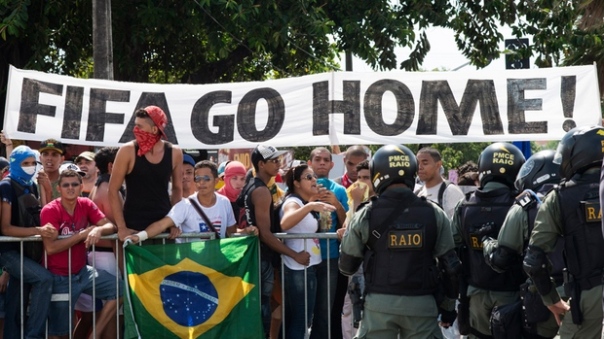
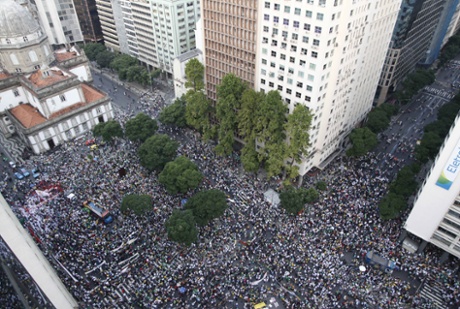

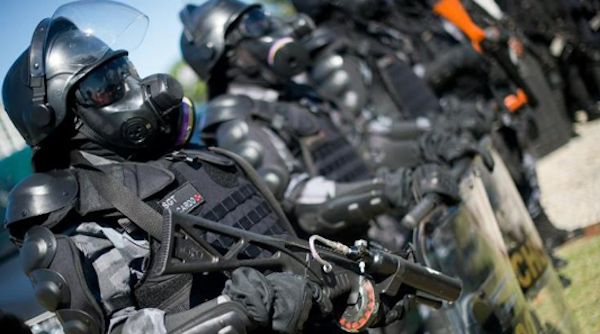
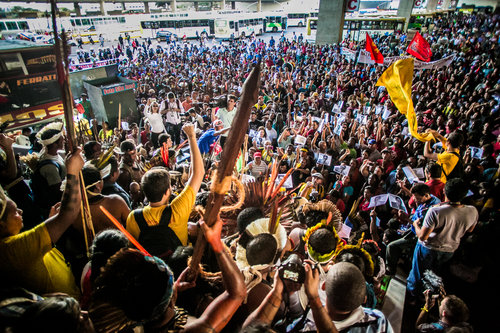
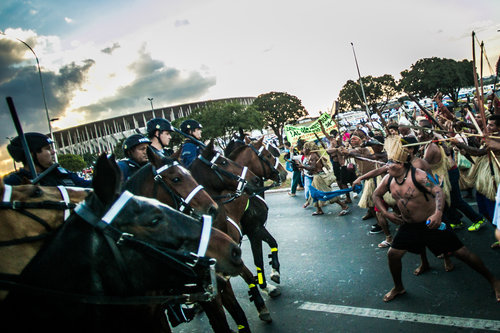
No comments:
Post a Comment